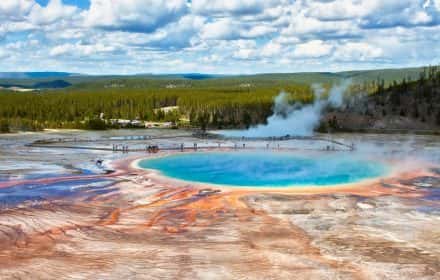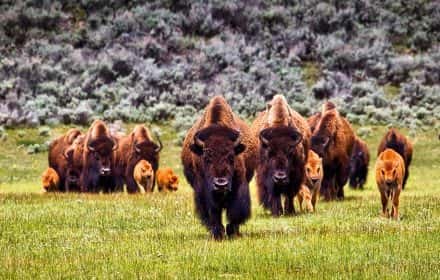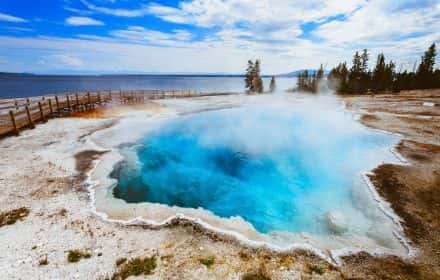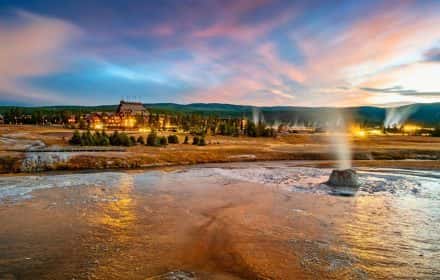This site uses affiliate links, meaning that if you make a purchase through our links, we may earn an affiliate commission.
Whether you are chasing waterfalls, craving stunning vistas, seeking rewarding hikes, or guide to the Grand Canyon of the Yellowstone has it all.
The Grand Canyon of the Yellowstone, situated within the heart of Yellowstone National Park, is an iconic masterpiece that will leave you in awe!
This guide will equip you with the know-how for an unforgettable visit to the Grand Canyon of the Yellowstone. From scenic drives to awe-inspiring hikes, along with a map and insider tips, we have got your adventure covered.
The Grand Canyon of the Yellowstone
- 1. Yellowstone National Park At-A-Glance
- 2. Introducing the Grand Canyon of the Yellowstone: A Stunning Geological Marvel
- 3. The Grand Canyon of Yellowstone: A Geological Journey Through Time
- 4. 3 Scenic Drives in the Grand Canyon of the Yellowstone
-
- 4.1. The North Rim Drive
-
- 4.1.1. Brink of the Lower Falls Trail
- 4.1.2. Lookout Point
- 4.1.3. Red Rock Point
- 4.1.4. Grand View
- 4.1.5. Inspiration Point
- 4.2. Brink of the Upper Falls Drive
- 4.3. The South Rim Drive
-
- 4.3.1. Upper Falls View
- 4.3.2. Sunset Point
- 4.3.3. Uncle Tom's Trail
- 4.3.4. Artist Point
- 5. Intrepid Scout's Tips for the Grand Canyon of the Yellowstone
Yellowstone National Park At-A-Glance
Before diving in, here are a few Yellowstone National Park highlights to help you plan your trip:
- When Is the Best Time to Visit Yellowstone National Park
The best time to visit Yellowstone National Park is during the shoulder seasons of spring (April and May) and fall (September and October). The weather is relatively mild and the crowds are thinner. Wildlife is also active during these times, making it an ideal opportunity for viewing animals. However, if you’re looking to experience the park’s full range of activities and amenities, the summer months offer the most options despite larger crowds. On the other hand, winter provides a unique chance for a serene and snowy adventure.
- Which Entrance Is the Best Gateway to the Park
Before you embark on your journey to Yellowstone, there is a pivotal decision to be made: which Yellowstone entrance is the best gateway for your adventure?
With a grand total of 5 entrances to Yellowstone to choose from, each offering its unique set of advantages and considerations, the task of selection might seem a tad overwhelming.
So here, we present your comprehensive guide to Yellowstone’s 5 entrances complete with insights on the optimal routes to reach each entrance, the nearest attractions to explore, and the best lodging options: 5 Entrances to Yellowstone (Which One Is the Best Gateway to the Park)
- Where to Stay When Visiting Yellowstone National Park
Accommodation options include lodges and cabins inside the park like the Old Faithful Inn, camping at various campgrounds, and lodging in gateway towns such as West Yellowstone, Gardiner, Cooke, and Cody.
Reservations are essential for in-park lodges and popular campgrounds due to high demand. Find out Where to Stay When Visiting Yellowstone (20 Best Lodging Options Inside and Near Yellowstone).
- How to Get Around in Yellowstone National Park
Unlike many other national parks, Yellowstone does not offer a public shuttle system. There is an automated shuttle pilot program in Canyon Village that launched in 2021, and there could be more to come in the future. But for now, having your vehicle is the only way to get around the park.
- How Much Does It Cost to Vist Yellowstone National Park
To visit Yellowstone National Park, you need to purchase a recreational day-use pass, which costs $35 per vehicle and is good for 7 consecutive days. You can purchase the pass right at the entrance to the park. If you are visiting several national parks then make sure to get America the Beautiful National Park Pass. This $80 pass is valid for 12 months and gets you into all 400+ national park sites!
- Check Yellowstone National Park Website for Trail Closures and Road Construction
You must check Yellowstone National Park’s Website for any trail or road closures before going to the park. You can check for updates HERE.
Introducing the Grand Canyon of the Yellowstone: A Stunning Geological Marvel
In the northeastern part of Yellowstone National Park lies the breathtaking Grand Canyon of the Yellowstone, a geological marvel that has captivated visitors for generations.
This awe-inspiring canyon stretches approximately 24 miles (39 kilometers) from its uppermost reaches to the lower end.
In several sections, the canyon width reaches to up to 4,000 feet (1,219 meters), adding to its grandeur.
At its deepest point, the canyon plunges to around 1,200 feet (366 meters). This dramatic depth varies throughout the canyon, creating stunning variations in perspective.

Lower Falls from Sunset Point on the South Rim Drive / Guide to the Grand Canyon of the Yellowstone
Central to the canyon’s formation is the mighty Yellowstone River, which flows through it.
The river is renowned for its turquoise waters and is one of the longest undammed rivers in the United States. It plays a pivotal role in carving and shaping the canyon’s unique features.
The Grand Canyon of the Yellowstone is graced with a series of remarkable waterfalls. Among the most famous are:
- Lower Falls: This towering waterfall, with a drop of around 308 feet (93 meters), is perhaps the most renowned feature of the canyon.
Lower Falls can be enjoyed from various vantage points, including the most popular Artist Point.
- Upper Falls: Located upstream from the Lower Falls, the Upper Falls is another impressive waterfall, boasting a drop of approximately 109 feet (33 meters).
The Grand Canyon of Yellowstone: A Geological Journey Through Time
The Grand Canyon of the Yellowstone is a living testament to the relentless forces of nature and the profound geological history that has shaped it over millions of years.
- Formation: This remarkable canyon owes its existence to the cataclysmic eruption of the Yellowstone supervolcano, an event that occurred approximately 640,000 years ago.
Blanketing vast stretches of North America in ash, this eruption left behind a massive caldera, or volcanic crater.
As time passed, the Yellowstone River began to flow through this caldera, carving its way through volcanic rocks and forming what we now know as the Grand Canyon of the Yellowstone.
- Geological Features: What sets this canyon apart is its kaleidoscope of colors adorning its walls.
These vibrant hues, ranging from deep yellows to fiery reds, are the result of hydrothermal activity, mineral deposits, and the oxidation of iron in the rocks. This geological kaleidoscope creates a visually stunning experience.
- Historical Significance: The Grand Canyon of the Yellowstone has long been a source of wonder and fascination.
Native American tribes, including the Crow and Shoshone, were among the first to appreciate its natural beauty.
The canyon’s fame grew as explorers, such as the Washburn-Langford-Doane Expedition in 1870, ventured into the area.
- Conservation: Recognizing its value and significance, the U.S. government designated Yellowstone as the world’s first national park in 1872.
This historic step was instrumental in preserving the Grand Canyon of the Yellowstone, ensuring that its geological wonders would be protected and accessible for future generations to marvel at and explore.
3 Scenic Drives in the Grand Canyon of the Yellowstone
The Grand Canyon of Yellowstone: 3 Scenic Drives with Hikes and Viewpoints
One of the best ways to explore the Grand Canyon of the Yellowstone is through its drives that offer panoramic vistas, and access to incredible viewpoints so you get a chance to witness the canyon’s beauty from various angles.
There are 3 routes that you can take: the North Rim Drive, the South Rim Drive, and the Brink of the Upper Falls Drive.
- Scenic Drive 1: The North Rim Drive:
The North Rim Drive is your gateway to the northern edge of the Grand Canyon of the Yellowstone.
This scenic route takes you along the canyon’s rim, offering sweeping views of the winding Yellowstone River and the dramatic rock formations that make this canyon so captivating.
Along the way, you will have the option of taking some short hikes that lead to amazing viewpoints.
- Scenic Drive 2: The Brink of the Upper Falls Drive
The Brink of the Upper Falls Drive is a separate drive on the North Rim of the Grand Canyon of the Yellowstone.
A short hike will lead you to the brink of the Upper Falls, where you can stand on the edge and witness the sheer power of the Yellowstone River as it plunges dramatically into the canyon below.
- Scenic Drive 3: The. South Rim Drive
The South Rim Drive is a route that guides you along the southern edge of the Grand Canyon of the Yellowstone. As you traverse this road, you will have ample opportunities to stop, do some hikes, and savor the breathtaking sights.
The North Rim Drive
The North Rim Drive is about 4 miles long round trip. The following are the key attractions:
- Brink of the Lower Falls
- Lookout Point
- Red Rock Point
- Grand View
- Inspiration Point
Brink of the Lower Falls Trail
The Brink of the Lower Falls Trail is one of the more challenging hikes within the Grand Canyon of the Yellowstone, but the breathtaking payoff makes it well worth the effort.

View of the Brink of the Lower Falls / Guide to the Grand Canyon of the Yellowstone
- Distance: 0.7 miles out-and-back
- Total Ascent: Approximately 600 feet
- Difficulty: Moderate to strenuous
- Duration: 30 to 60 minutes
The trail starts at the canyon’s rim and it descends rapidly into the depths below. Two viewing spots will give you different observation angles.

Brink of the Lower Falls / Guide to the Grand Canyon of the Yellowstone
As you make your way back to the rim, take your time because the high altitude will leave you breathless.
GOOD TO KNOW: The good news is that there are benches conveniently located at the end of almost all the switchbacks. These resting points offer a chance to not only catch your breath but also take in the stunning surroundings as you make your way back to the top.
Lookout Point
The next stop on the North Tim Drive is Lookout Point.
To reach Lookout Point, start from a parking area adjacent to the North Rim Trail. From there, follow the walkway leading to Lookout Point. A short descent of thirteen steps takes you to the lookout, making it easily accessible for everyone.
Lookout Point offers a mesmerizing perspective of the 308-foot Lower Falls, a magnificent tier of Yellowstone Falls.

Lookout Point / Guide to the Grand Canyon of the Yellowstone
Red Rock Point
The next stop on the North Rim Drive is Red Rock Point.
To access Red Rock Point, follow the well-maintained trail, which includes both paved sections and wooden stairs.
While the hike is moderately challenging due to the elevation change, the effort is truly worthwhile for the exceptional views of the Lower Falls.

View of the Trail Leading to Red Rock Point / Guide to the Grand Canyon of the Yellowstone
- Distance: 0.6 miles out-and-back
- Difficulty: Moderate
- Total Ascent: 260 feet
- Time: Approximately 30 minutes
As you make your way down, you will be rewarded with one of the closest and most impressive views of the Lower Falls. The thundering cascade of water, the colorful canyon walls, and the immense scale of the landscape all come into view from this remarkable vantage point.

Red Rock Point / Guide to the Grand Canyon of the Yellowstone
Grand View
Grand View is your next stop and it is conveniently located just along North Rim Drive, making it easily accessible by car.
You can park nearby and step out to enjoy the panoramic views.
Unlike some viewpoints that focus on the Lower Falls, Grand View provides a distinct angle, allowing you to look directly down the canyon to the east. From this vantage point, you will observe the Yellowstone River flowing 600-800 feet below where you stand.

Grand View / Guide to the Grand Canyon of the Yellowstone
While the view to the southwest is somewhat limited due to the narrowness of the canyon, the colorful cliffs that define the canyon’s walls remain a breathtaking sight.
Inspiration Point
The next stop is Inspiration Point. It is easily accessible just via a short spur road off of North Rim Drive.
As you approach the parking area for Inspiration Point, you will pass a gigantic boulder sitting among the pine trees. This colossal rock was left behind by the glaciers as they retreated at the end of the last Ice Age.
Inspiration Point consists of three overlooks, accessible via a series of boardwalks and stairs. Each of these overlooks provides slightly different views of the canyon to the west.

Inspiration Point / Guide to the Grand Canyon of the Yellowstone
Brink of the Upper Falls Drive
Brink of the Upper Falls Drive is located on the North Rim Drive as well, however, there is a separate entrance to it from the Grand Loop Drive.
GOOD TO KNOW: To reach the Brink of the Upper Falls, follow North Rim Drive, then turn onto Grand Loop Drive, which leads to Brink of the Upper Falls Drive. It is a short drive no more than 5 minutes.
Brink of the Upper Falls features three distinct overlooks, each offering a unique perspective of the majestic Upper Falls and the Yellowstone River:
- Upper Overlook: The Upper Overlook at Brink of the Upper Falls offers a vantage point at an elevation of 270 feet, providing a captivating view of the Yellowstone River. This viewpoint allows you to witness the river’s course as it approaches the falls.
- Middle Overlook: Located at an elevation of 504 feet, the Middle Overlook not only provides a view of the river but also offers a glimpse of the lower overlook platform.
- Lower Overlook: The Lower Overlook, situated at an elevation of 623 feet, is where you’ll find the best view of the Upper Falls. A short and accessible walk takes you to the platform, which offers a stunning and up-close view of the falls. While the rocks partially obscure the view of the Upper Falls it is still worth the visit.

View of the Brink of the Upper Falls / Guide to the Grand Canyon of the Yellowstone
The South Rim Drive
The South Rim Drive is about 3 miles out and back.
Following are the stops along the drive:
- Upper Falls View
- Sunset Point
- Uncle Tom’s Trail
- Artist Point
Upper Falls View
Upper Falls View will be your first stop on the South Rim Drive. It is an easy walk from the Uncle Tom’s parking area.
There are two viewpoints at the Upper Falls View. First, you will be able to spot the old Canyon Bridge upstream of the waterfall. And, Crystal Falls can be seen from the left overlook.

View of the Brink of the Upper Falls / Guide to the Grand Canyon of the Yellowstone
Sunset Point
To reach Sunset Point take a short and easy 0.6-mile out-and-back hike that allows you to enjoy a leisurely walk while enjoying the views.
- Distance: 0.6 miles out and back.
- Difficulty: Easy
- Total Ascent: Approximately 70 feet.
- Time: 15 to 30 minutes
As you follow the trail, which gently ascends approximately 70 feet, you will be treated to a view of the Upper Falls. This perspective may offer a more favorable angle and lighting for appreciating the falls compared to the Upper Falls View.
Uncle Tom's Trail
Uncle Tom’s Trail is the oldest and most famous trail into the canyon. It is the closest trail to the face of Lower Falls.
- Distance: 0.8 miles (round trip)
- Time: 1 hour
- Elevation Change: 500 feet
- Trailhead: Uncle Tom’s Point parking area, near the South Rim of the Grand Canyon of the Yellowstone.

Uncle Tom’s Trail / Guide to the Grand Canyon of the Yellowstone
The trail makes use of a series of stairways, containing more than 300 steps, to reach an observation platform directly in front of the Lower Falls.
The views from here are simply awe-inspiring, and you can feel the mist from the waterfall on your face.

Uncle Tom’s Trail / Guide to the Grand Canyon of the Yellowstone
GOOD TO KNOW: Regrettably, Uncle Tom’s Trail has been closed for an extended period, and there is currently no information available regarding its reopening date.
I eagerly await its eventual reopening and hope that it will be accessible soon. Hopefully, when you are visiting, you will be able to enjoy this trail!
Artist Point
Artist Point is an absolute must-visit for anyone exploring the Grand Canyon of the Yellowstone. This iconic viewpoint is situated at the culmination of South Rim Drive and offers an extraordinary perspective of the canyon’s splendor.
A 5-minute short, paved trail takes you from the parking lot to the mesmerizing Artist Point.
As you descend along the trail, the Lower Falls of the Yellowstone River gradually come into view through the dense spruce trees. The sight of the 308-foot Lower Falls from Artist Point is nothing short of breathtaking.

Artist Point / Guide to the Grand Canyon of the Yellowstone
Artist Point is arguably one of the most photographed features in Yellowstone National Park.
Even from a distance of nearly a mile, the sheer power of the river as it plunges into the canyon is palpable. The towering, multi-colored cliffs rising above the frothing waters create a scene of beauty!
Intrepid Scout's Tips for the Grand Canyon of the Yellowstone
- To help you make the most of your time, here are my top 4 absolute must-visit viewpoints:
1. Artist Point (South Rim)
2. Brink of the Lower Falls (North Rim)
3. Lookout Point (North Rim)
4. Upper Falls View (South Rim)
- Best Time to Visit:
Visiting during sunrise or sunset enhances the canyon’s colors and provides a magical atmosphere.
Also, visiting early during the day, or late in the afternoon will ensure that you have a more peaceful and personal experience.
The Grand Canyon of Yellowstone gets swarmed between 10 a.m. to 4 p.m. During this time, it is hard to find a parking spot.
- North Rim vs. South Rim:
Both rims offer spectacular vistas, but if you are choosing one, South Rim provides iconic viewpoints like Artist Point and is generally more accessible.
- If You Only Have Time for One Thing:
Do not miss the opportunity to witness the Lower Falls from Artist Point. It is an iconic view that defines the beauty of this natural wonder.
You Might Also Like
Perfect One Day in Yellowstone (8 Things You Can’t Miss!)
Guide to the Upper Geyser Basin in Yellowstone (5 Sections, Trails, Best Attractions+Maps)
5 Entrances to Yellowstone (Which One Is the Best Gateway to the Park)
Where to Stay When Visiting Yellowstone (20 Best Lodging Options Inside or Near the Park)
17 Short and Easy Hikes in Yellowstone: Perfect for All Ages (Maps+Useful Tips)
23 Best Stops on Yellowstone Lower Loop Drive (Maps+Useful Tips)
16 Best Stops on Yellowstone Grand Loop Drive (Maps+Useful Tips)
17 Most Scenic Hikes in Grand Teton National Park You Need to Explore
5 Best Places to See Wildlife in Grand Teton National Park (Maps +Tips)
6 Best Photography Locations in Grand Teton (+Useful Photo Tips)
Did You Find This Useful?
Why Not Save Guide to the Grand Canyon of the Yellowstone to Your Pinterest Board!

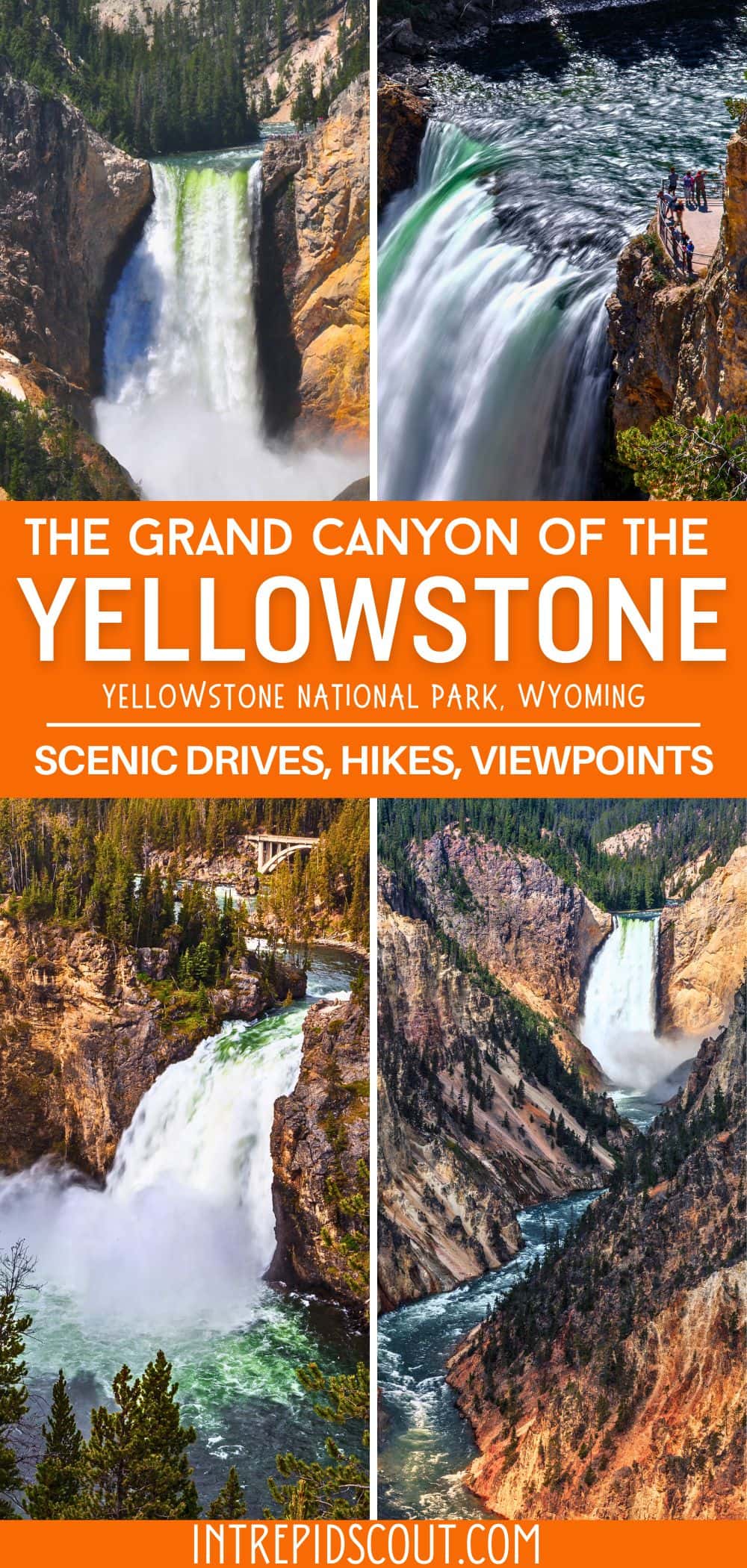
Now, It Is Your Turn, I Would Like to Hear Back from You!
Are you planning your trip to Yellowstone National Park?
Please let me know! Drop me a quick comment right below!
Click on any of the images below to get inspired and to help you with the planning process for your trip to Yellowstone National Park!
